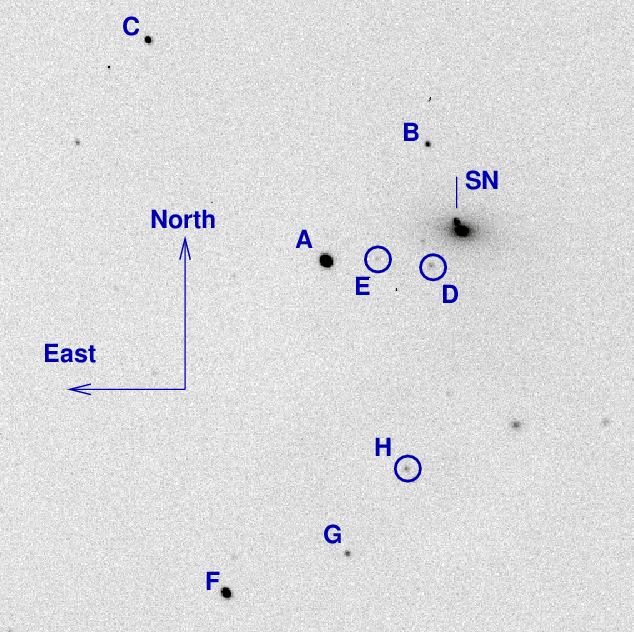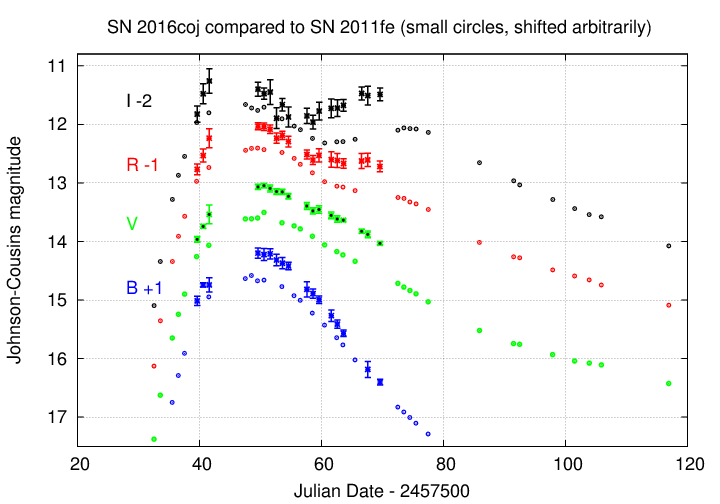
On the night of Jun 29/30, 2016, I observed SN 2016coj in NGC4125 on a bea-u-ti-ful night.
The main setup was:
Notes from the night
SN 2016coj is a Type Ia supernova in the relatively nearby galaxy NGC4125. It was discovered by the KAIT group some time before maximum light:
NGC 4125 RA = 12:08:05.7 Dec = +65:10:30 (J2000)

The AAVSO sequence team kindly provided photometry for stars near this object. You can see their full photometric sequence on their website. Below, I show only the members of that sequence which fall into my very small field of view -- taken from AAVSO sequence X16266F.
letter B sigB V sigV R sigR I sigI ------------------------------------------------------------------------ B 15.198 0.086 14.133 0.052 13.627 0.116 13.155 0.156 C 13.317 0.093 12.673 0.058 12.316 0.121 11.980 0.161 -------------------------------------------------------------------------
On this night, I took four series of 30-second dark frames: one set right after flats, then three other sets at intervals of 18, 40, 100 minutes after the initial set (the last one after observing the SN). The CCD-TEMP keyword in the FITS header indicated a constant temperature of about -14 degrees Celsius. Despite the constant CCD temperature (if it really WAS constant), the dark current changed -- look at the histogram below.
The initial set has a different (higher) distribution of pixel values than the subsequent three sets.

Is it possible that the body of the camera grows warm during the day (it sits out in the hot dome), and is still cooling off during the start of the night? The electronics may _say_ that the chip is at -14 Celsius, but they may be inaccurate for some reason ...
I decided to combine all the darks in the final 2 sets (a total of 20 frames) to create the master 30-second dark that I would use for the SN images.
I took sets of 15-20 images in each filter, guiding in BVRI I used longer guide exposure times (12 sec) in B and I. I discarded any trailed images. When switching from VR to I, I re-focused the telescope. The FWHM decreased in the focus images from about 3.5 to about 2.5 pixels, so I guess it was a good idea.
As explained in the notes to Jun 14, 2016, I used the "rotsub" technique to remove the galaxy's light at the position of the SN.
On this night, I used "method 2", which means performing "rotsub" on each individual image, then combining all the resulting images in a passband to make a "master rotsub" image.
Using aperture photometry with a radius of 4 pixels (radius of 5.5 arcsec) [note that this gave better zero-point calibration than a 3-pixel aperture], I measured the instrumental magnitudes of a number of reference stars and the target. Following the procedures outlined by Kent Honeycutt's article on inhomogeneous ensemble photometry, I used all stars available in each image to define a reference frame, and measured each star against this frame. I used the interim reference magnitudes above plus color terms which I am currently revising -- so please treat these results as preliminary to convert the ensemble instrumental magnitudes to the standard Johnson-Cousins BVRI scale.
Note that in the graph below, I combine data calibrated with UCAC4 photometry (first few weeks) with recent data calibrated with AAVSO photometry. That's inconsistent, and I'll re-compute all magnitudes later.
filter mag mag_uncert Julian Date
SN B = 15.402 +/- 0.048 (ens 0.047 zp 0.007) 2457569.62133
SN V = 14.033 +/- 0.023 (ens 0.022 zp 0.006) 2457569.59769
SN R = 13.719 +/- 0.092 (ens 0.019 zp 0.090) 2457569.59008
SN I = 13.488 +/- 0.108 (ens 0.028 zp 0.104) 2457569.60844
Below is a preliminary light curve, based on RIT Observatory measurements. I also show measurements of SN 2011fe in M101, an ordinary type Ia supernova, shifted arbitrarily.

Last modified 06/28/2016 by MWR.